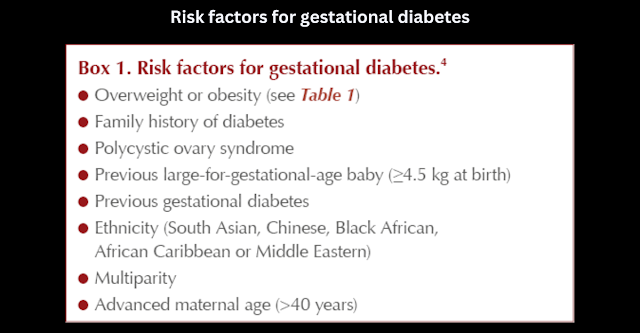Gestational diabetes symptoms and treatment
Causes of High Blood Sugar Levels During Pregnancy
Gestational diabetes is a
condition in which your blood sugar levels become high during pregnancy. It
affects up to 10% of pregnant women each year. It also affects pregnant women
who have never been diagnosed with diabetes.
There are two types of
gestational diabetes. Women with type 1 can control it with diet and exercise.
Women with type 2 need to take insulin or other medications.
Gestational diabetes goes
away after the baby is born. But it can affect your baby's health during
pregnancy, and it also increases your risk of developing type 2 diabetes later
in life.
Symptoms of gestational
diabetes
Women with gestational
diabetes usually do not have specific symptoms. Most women do not know
themselves and are diagnosed during routine screening or ultrasound.
Common symptoms include
You may be more thirsty
than usual.
You may feel more hungry
and eat more than usual.
You may urinate more than
usual.
Causes of gestational diabetes
When you eat, your
pancreas releases insulin, a hormone that helps move sugar called glucose from
your blood into your cells, which use it for energy.
During pregnancy, your
placenta also makes hormones that cause your blood glucose to build up.
Normally, your pancreas can send out enough insulin to handle it. But if your
body can't make enough insulin or stops making insulin, your blood sugar levels
rise, and you get gestational diabetes.
Risk factors for gestational diabetes
You may be more likely to develop gestational diabetes if you were overweight before you became pregnant.
Have blood sugar levels that are slightly higher than normal but not high enough to cause diabetes (this is called pre-diabetes)
Have a family history of
diabetes
Have had gestational
diabetes before
Have high blood pressure,
high cholesterol, heart disease, or other medical complications
Have given birth to a
large baby (a baby weighing more than 9 pounds)
Have had a miscarriage
Having given birth to a
baby who was stillborn or had some birth defects
Pregnancy at an older age
Gestational Diabetes Tests and Diagnosis
Gestational diabetes usually occurs in the second half of pregnancy. Your doctor will test you for it between 24 and 28 weeks of pregnancy, or sooner if you are at high risk.
Your doctor will give you a glucose tolerance test: You will drink 50 grams of glucose in a sugary drink, which will raise your blood sugar. An hour later, you will have a blood glucose test to see how your body handles all that sugar.
If the results show that
your blood sugar is above a certain level, you will need a 3-hour oral glucose
tolerance test, which means you will have a blood glucose test 3 hours after
drinking a 100-gram glucose drink. Your doctor may also test you by fasting for
12 hours, then giving you a 75-gram glucose drink and a 2-hour blood glucose
test.
If you are at high risk
but your test results are normal, your doctor may test you again after your
pregnancy to make sure you still don't have diabetes.
Treatment for gestational diabetes
If you have gestational diabetes, you will need treatment as soon as possible to keep yourself and your baby healthy during pregnancy and birth.
Check your blood sugar
levels four or more times a day.
Keep your urine tested
for ketones, chemicals that can help you know if your diabetes is under
control.
Eat a healthy diet.
Make exercise a habit
Your doctor will monitor your weight and your baby's growth. He or she may give you insulin or other medications to help control your blood sugar.
Precautions
Eat natural sugars like
fruits, carrots, and raisins. Avoid sugary snacks like cookies, candy, and ice
cream. Include vegetables and whole grains in your diet, and keep your portion
sizes moderate.
Staying active is a good
way to help manage your blood sugar. Be sure to do light exercise and walking
during pregnancy.












